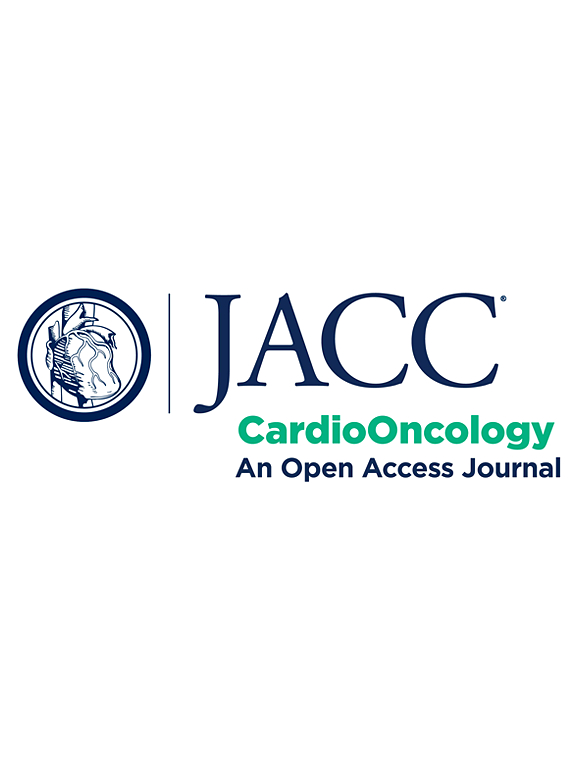前列腺癌男性患者的脂肪含量和肌肉力量与心血管预后
IF 12
1区 医学
Q1 CARDIAC & CARDIOVASCULAR SYSTEMS
引用次数: 0
摘要
背景关于雄激素剥夺疗法(ADT)对前列腺癌(PC)患者的身体影响,以及这些脂肪和力量指标与心血管预后之间关系的数据十分有限。目标本研究的主要目标是评估PC患者的脂肪和力量指标与心血管预后(心血管死亡、心肌梗死、中风、心力衰竭、动脉血管再通、外周动脉疾病和静脉血栓栓塞)之间的关系。这项国际性前瞻性队列研究纳入了 3967 名在过去 12 个月内确诊为 PC 或首次接受 ADT 治疗的患者。结果参与者的平均年龄为68.5岁,其中1731人(43.6%)接受过ADT治疗。ADT与体重增加1.6%、腰围增加2.2%、臀围增加1.6%、腰臀比增加0.1%、手握力下降27.4%和步速下降0.1%有关。高腰围和低握力与不良心血管后果相关。在对年龄、教育程度、种族、吸烟和酗酒、体力活动、心血管疾病、肾小球滤过率和 ADT 使用情况进行调整后,腰围高于最高四分位数(110 厘米)和握力低于最低四分位数(29.结论 在 12 个月的随访中,ADT 与肥胖增加和力量下降有关。高腰围和低基线力量与未来心血管不良后果有关。本文章由计算机程序翻译,如有差异,请以英文原文为准。
Adiposity and Muscle Strength in Men With Prostate Cancer and Cardiovascular Outcomes
Background
There are limited data on the physical effects of androgen deprivation therapy (ADT) for prostate cancer (PC), and on the relationships of such measures of adiposity and strength to cardiovascular outcomes.
Objectives
The primary objective of this study was to evaluate the relationships of measures of adiposity and strength to cardiovascular outcomes (cardiovascular death, myocardial infarction, stroke, heart failure, arterial revascularization, peripheral arterial disease, and venous thromboembolism) in patients with PC. A secondary objective was to characterize the relationships between ADT use and 12-month changes in these physical measures.
Methods
This international, prospective cohort study included 3,967 patients with PC diagnosed in the prior 12 months or being treated with ADT for the first time. Median follow-up duration was 2.3 years.
Results
Participants’ mean age was 68.5 years, and 1,731 (43.6%) were exposed to ADT. ADT was associated with a 1.6% increase in weight, a 2.2% increase in waist circumference, a 1.6% increase in hip circumference, a 0.1% increase in waist-to-hip ratio, a 27.4% reduction in handgrip strength, and a 0.1% decrease in gait speed. High waist circumference and low handgrip strength were associated with adverse cardiovascular outcomes. Adjusting for age, education, race, tobacco and alcohol use, physical activity, cardiovascular disease, glomerular filtration rate, and ADT use, waist circumference above the highest quartile (110 cm) and handgrip strength below the lowest quartile (29.5 kg) were associated with higher likelihoods of a future cardiovascular event, with respective HRs of 1.40 (95% CI: 1.03-1.90; P = 0.029) and 1.59 (95% CI: 1.14-2.22; P = 0.006).
Conclusions
ADT was associated with increased adiposity and reduced strength over 12-month follow-up. High waist circumference and low baseline strength were associated with future adverse cardiovascular outcomes.
求助全文
通过发布文献求助,成功后即可免费获取论文全文。
去求助
来源期刊

Jacc: Cardiooncology
Multiple-
CiteScore
12.50
自引率
6.30%
发文量
106
期刊介绍:
JACC: CardioOncology is a specialized journal that belongs to the esteemed Journal of the American College of Cardiology (JACC) family. Its purpose is to enhance cardiovascular care for cancer patients by publishing high-quality, innovative scientific research and sharing evidence-based knowledge.
The journal aims to revolutionize the field of cardio-oncology and actively involve and educate professionals in both cardiovascular and oncology fields. It covers a wide range of topics including pre-clinical, translational, and clinical research, as well as best practices in cardio-oncology. Key areas of focus include understanding disease mechanisms, utilizing in vitro and in vivo models, exploring novel and traditional therapeutics (across Phase I-IV trials), studying epidemiology, employing precision medicine, and investigating primary and secondary prevention.
Amyloidosis, cardiovascular risk factors, heart failure, and vascular disease are some examples of the disease states that are of particular interest to the journal. However, it welcomes research on other relevant conditions as well.
 求助内容:
求助内容: 应助结果提醒方式:
应助结果提醒方式:


